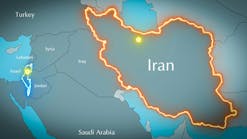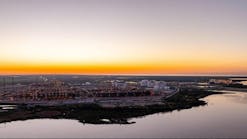The alliance seeks to position Phillips as a major owner and participant in the worldwide LNG industry, and Bechtel-which has designed and built more than 35% of the world's liquefaction capacity-as an equity participant in these projects, as well as the premier builder of LNG complexes, the companies said.
Bechtel, which has been designing and building LNG complexes since 1959, is combining its expertise with Phillips to provide customers greater value and better project economics, among other potential benefits, the companies said.
Phillips and Bechtel have established an LNG process development center at Bechtel's offices in Houston, which is staffed by personnel from both companies in support of the alliance and its objectives.
Alaska experience
Phillips' Optimized Cascade process was first used in 1969 in the Phillips-Marathon Oil Co. gas liquefaction plant project at Nikiski, on Alaska's Kenai Peninsula.
The single-train LNG plant at Nikiski was designed and built by Bechtel and was the first complex to ship LNG volumes to Japan.
Phillips has achieved 27 years of uninterrupted supply to Japan. Plant capacity has been increased over the years and is now more than 220 MMcfd of gas, yielding about 6.2 million cu m of LNG.
Phillips has a 70% share interest in the Kenai LNG project and is responsible for operation of the liquefaction facilities. Marathon has a 30% interest and is responsible for the operation of two tankers, now named Polar Eagle and Arctic Sun.
A new version of the process will be used by Atlantic LNG Co. of Trinidad & Tobago in its LNG complex (see story, p. 12, and OGJ, July 8, p. 36).
The process
The Phillips-licensed Optimized Cascade process was originally developed to devise a refrigeration cycle that could be used in liquefaction to permit easy start-ups and smooth operations for a wide range of gas feed volumes and compositions, Phillips' Don L. Andress said in a summer 1996 report for the Institute of Gas Technology's LNG Observer.
Andress, in Phillips' LNG technology licensing division, said using these criteria as design parameters, "Computer programs were developed to calculate the total process requirements for a cascade-cycle system using propane, ethylene, and methane as the refrigerants."
Models were then created, he said, "to optimize the cycle and determine the optimal liquefaction train configuration to maximize production yields of LNG."
According to Andress, the company has studied larger plant configurations since the Alaska plant was built, ranging in size from the original Kenai plant train size of 1.2 million metric tons/year to 3.5 million tons/year. The plant's annual capacity is more than 1.5 million tons/year.
"With the Phillips Optimized Cascade Process," Andress said, "very large LNG trains can be built because of the manner in which the liquefaction trains can be configured using plate-fin-type heat exchangers."
According to Phillips, the process provides: production flexibility as the composition of feed gas changes; nitrogen removal, minimizing power requirements per MMBTU of product and lowering marine transportation costs; vapor recovery, returning to the methane refrigeration system, recovering both vapor and its refrigeration; rate flexibility, ranging from near zero to 100% of capacity; minimal space requirements, resulting from use of compact plate-fin-type heat exchangers; and ease of operation, stemming from pure component refrigerants of essentially constant molecular weight.
Improvements
Phillips has continually improved the original process since it was first used in Alaska, Andress said.
"One change...is the modification of the methane refrigerant circuit so that it is now an open circuit or a feedflash system rather than the original closed circuit used at Kenai," Andress said. He said the modification eliminates the separate fuel gas compressor.
Also, Andress said, "Storage vapors and vapors from tanker loading are recovered and fed back to the liquefaction train and reliquefied rather than being routed directly to fuel or flare, thereby increasing LNG production (see diagram)."
Andress said other modifications to the basic configuration at Kenai that could be considered are the replacement of the dual gas turbines/compressors used on each refrigerant with a single gas turbine/compressor on each refrigerant, particularly if two or more trains are to be installed. Also, if the feed gas has significant amounts of C2+ hydrocarbons, a hydrocarbon liquid draw system would be included.
Copyright 1996 Oil & Gas Journal. All Rights Reserved.

